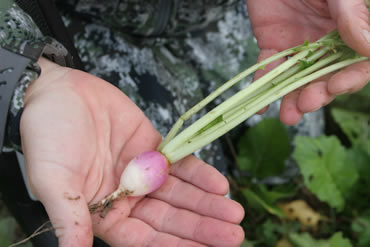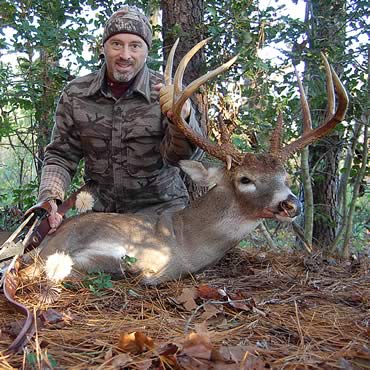Do you want to grow bigger deer or attract them for hunting?
When Ray Scott started the Whitetail Institute in 1988, he sold a single product: white clover. Although Scott, better-known as the founder of BASS at the time, was interested in the nutritional value of clover, few hunters gave it much thought. They just wanted something that would draw deer during hunting season.
Times have changed.
What started as little more than a haphazard way to attract whitetails has blossomed into an exact science. Instead of just planting a food plot, hunters are planting food plots with specific purposes.
Whether a place to hang a treestand during the early archery season, a late-season plot to draw bucks when other food sources have dwindled or a summer plot that provides high-quality forage when nutrition is vital, today’s food plots are grown to fulfill specific goals.
“There’s no question hunters are much more educated and sophisticated when it comes to food plots,” says Whitetail Institute vice president Steve Scott. “Many of our customers know exactly what they want to accomplish, and they’re buying products that meet a specific need.”
NUTRITION MATTERS
Attraction, or hunting, plots are still the most popular choice among deer hunters, but nutrition plots have gained a huge following among savvy recreational wildlife managers.
Summer nutrition plots are grown specifically to provide protein — one of the primary ingredients that promotes antler growth — when other food sources aren’t available.
There’s still plenty of debate in the science community about the effect of food plots on antler growth, but almost everyone agrees a food plot that gives deer high levels of protein is beneficial to bucks, does and even fawns.
Anything that helps young deer get a boost early in life will help them grow better and bigger later. There’s no question deer with access only to foods with low protein levels are generally less healthy than those with high-protein diets.
Fortunately, all of the major summer food plot plants are designed to provide high levels of protein. Some, like forage soybeans, produce upwards of 40 percent. Clover and alfalfa produce up to 30 percent protein, and chicory can have protein levels exceeding 20 percent. Be warned, though. A plant with 40 percent protein isn’t going to give you (or more specifically, your deer) any more benefit than something like chicory, with about half the protein level of beans.
Quality Deer Management Association director of education and outreach Kip Adams says deer utilize only about 16 percent protein, no matter how much protein individual plants contain.
FORGET PROTEIN
“Almost everything available for summer nutrition plots contains enough protein,” says Adams. “Instead of worrying about protein levels, we should pay more attention to giving deer adequate nutrition from early spring through late summer.”
Remember, spring green-up provides an enormous amount of natural food early in the year, much of it high in necessary nutrients. But as the summer progresses, those foods become less abundant and much less palatable. Nutrition levels decline in the natural foods that remain. That’s when food plots come into the equation. By providing protein-rich forage when it’s needed most, nursing does will grow bigger, healthier fawns, and bucks will go into the breeding season in better shape.
Adams says soybeans are an excellent choice, but they are often too good and deer will devour them as soon as they sprout. The only way around that is to plant enough, at least an acre, depending on your local deer density. Two acres is even better. Smaller plots might not last long enough to provide essential nutrition when it’s needed most. That’s why hunters should evaluate their situation before jumping into nutrition plots.
“If you have a limited amount of space, a better choice than something like beans is a clover-chicory mix,” Adams said. “Clover is one of the first plants to provide high-protein forage in the spring, and it will last into the early summer before it goes dormant again. Chicory is somewhat more drought-tolerant than clover, so it can provide adequate forage during the summer.
“Beans are a great choice to fill that summer forage gap, but again, you need at least an acre. Cow peas are an excellent alternative to beans because they produce such a large amount of forage in a smaller space.”
 A PLACE TO HUNT
A PLACE TO HUNT
Size is far less important for hunting plots, says Adams. A plot of clover as small as a tenth of an acre will draw deer. However, just as a high deer density can demolish a small nutrition plot, too many deer can wipe out an attraction plot, limiting the time you can hunt over it.
Space isn’t a limiting factor for Virginia hunter Curt Lytle. He has plenty of land. But summer nutrition isn’t a limiting factor, either. His 160-acre farm in southeast Virginia is surrounded by giant food plots in the form of commercially-grown soybeans and peanuts. While they aren’t planted for deer, both legumes are a favorite of whitetails wherever they are grown. That’s one reason Lytle doesn’t plant summer nutrition plots.
Soon after he bought his land in 1994, he tried a combination of climbing beans and milo, both excellent summer forage plot plants and both marketed for whitetail food plots. However, the deer didn’t touch them. He doesn’t know why they wouldn’t eat the plants, but he gave up and switched entirely to a variety of plots that attract deer during his state’s lengthy hunting season.
“I plant beans, but I wait until June to plant two plots, and July to plant two more,” Lytle said. “The idea is that the deer will start eating them in August and September and into October, or even November. I use Plot Savers to keep the deer out until the beans get about a foot high, so my primary purpose is to hunt over them, not to provide nutrition.”
Those beans have been his best draw in the early season, but once the beans are gone, Lytle and the deer switch to one of the four white clover plots scattered around his farm. The clover regenerates in mid-September and stays vibrant well into the winter. He also top-sows crimson clover seed over the bean fields, typically in August. That allows the clover enough time to sprout and become established by late October, providing good forage and another hunting option throughout the winter.
“My best late-season plots consist of Austrian winter peas,” says the 43-year-old mechanical engineer and dedicated bowhunter. “The deer won’t touch them until they’ve been subjected to a couple of hard frosts, which, usually isn’t until well into the hunting season, even as late as December, in my area.”
Various brassica varieties, which include turnips, kale, rape and other species, make prime late-season attraction plots. Just as Lytle’s local deer herd won’t touch his peas until they’ve been hit with a couple of frosts, whitetails shun brassicas until the plants have been subjected to a cold snap. High in carbohydrates, brassicas have become one of the go-to attraction plants for hunters everywhere.
 DOUBLE-DUTY PLANTS
DOUBLE-DUTY PLANTS
Brassicas, however, are good only for late season hunting and don’t provide any benefit in the summer. Nor do they draw whitetails in the early fall. That’s why many hunters are now relying on a handful of plants that not only feed deer during the spring and summer, but also draw them during hunting season.
Fortunately, some plot plants can serve as nutrition and attraction plots. White clover is arguably the best all-purpose food plot plant because it stays green much of the year and attracts deer well into hunting season.
“White clovers have one issue, says Pennington Seed national sales manager John Carpenter. “They are slow the first year, so you have very little to hunt over. After that, you get a great crop.”
Carpenter recommends a mix to get around the issue of the plant’s slow first season. “I’ll use our Rackmaster Elite product as an example,” he said. “It’s a combination of small grains, winter peas, brassicas, chicory and white clover. From the onset, you get a great immediate plot with the small grains and winter peas. In mid-winter, the brassicas do their thing, and when the annuals are gone, you have the white clover and chicory lasting for years.
“A mix can give hunters an immediate food plot that deer are attracted to the entire season.”
Adams also recommends dividing medium or large plots to include more than one type of plant.
“If I had only one acre, I’d plant half in a clover-chicory mix, a quarter in brassicas and the rest in something like cow peas to offer at least some late-summer nutrition,” he says. “If you aren’t sure, try experimenting with different things to see what works for you. To me, that’s half the fun of food plots.”
Read Recent Articles:
• Rainy Days and Mondays ... Don’t always have to get you down.
• The Outside-In Approach: How to hunt the entire season without burning out your best stands.
• All in a Day’s Work: Awesome buck gives new meaning to the Eastern Shore’s scenic nickname.
This article was published in the September 2012 edition of Buckmasters Whitetail Magazine. Subscribe today to have Buckmasters delivered to your home.